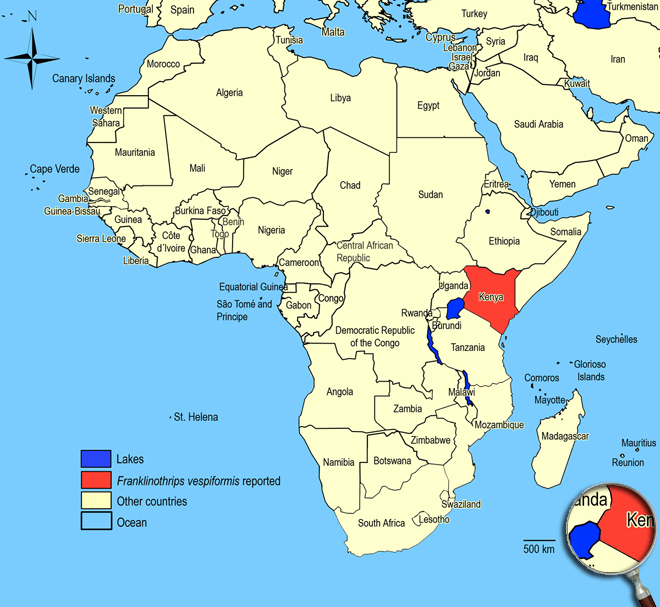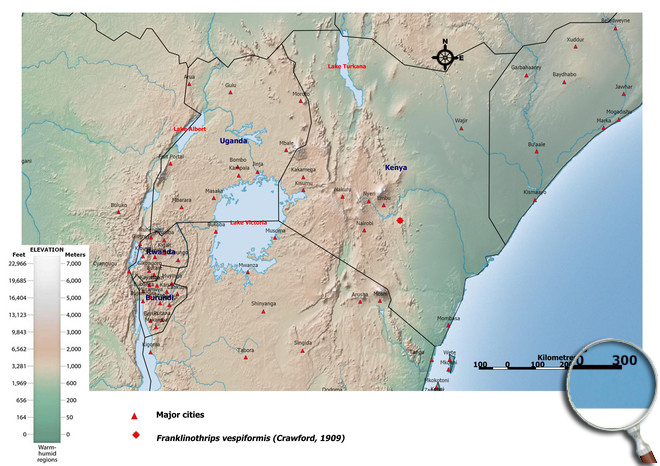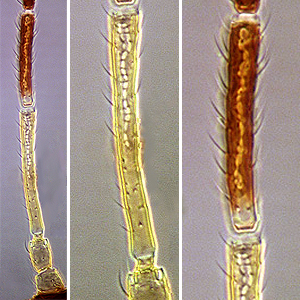Franklinothrips vespiformis (Crawford, 1909)
Aeolothripidae, Terebrantia, Thysanoptera
Figures
Fig. 1: Antennal segments I-IV, III. and IV. antennal segment with linear sensory areas formed of irregular scallops
Fig. 2: Head dorsal with ocellar triangle and caudal elongated compound eye
Fig. 3: Pronotum
Fig. 4: Meso- and metanotum
Fig. 5: Fore wing and fore wing apical region
Fig. 6: Fore- and hind wing
Fig. 7: Female, dorsal view
Fig. 8: Female, feeding on a thrips larva
Introduction and recognition
Franklinothrips vespiformis is a generalist predator and attacks a wide variety of small arthropod pests, including various thrips species. Female macropterous and with a wasp-like waist (Fig. 7 and Fig.8). Body, legs and antennae dark brown except for antennal segments I-III yellow, abdominal segments 1-3 pale yellow (2 and 3 with anterior margins brown), and segment 10 yellowish; femora yellowish at apex; fore wings banded, brown with a small sub-basal pale area, a transverse white band medially, and a variable white spot near apex just within the dark costal ring-vein (Fig. 5 and Fig. 6). Antennae 9-segmented, unusually elongate; segments III & IV exceptionally long and slender, III more than 3 times as long as II, and about 15 times as long as wide; III & IV with linear sensory areas extending into basal quarter of segment, these areas with characteristic scalloped margins (Fig. 1). Head and pronotum without long setae (Fig. 2); head wider than long, recessed into pronotum, eyes prolonged ventrally; pronotum broader anteriorly than posteriorly (Fig. 3). Mesonotum with 1 pair of setae medially. Metanotum without sculpture medially, 1 pair of setae at anterior margin and 1 pair near posterior (Fig. 4). Tarsi 2-segmented, fore tarsus with a small terminal hamus that recurves to meet apex of a small seta. Fore wing slender with apex rounded, cross veins not distinguishable; costal margin with setae but no cilia (Fig. 5). Tergites with discal setae small; tergite X with pair of very small trichobothria. Sternites III-VI with 2 pairs of posteromarginal setae, and 2 pairs of discal setae laterally; VII with 4 pairs of posteromarginal setae, and 2 pairs of discal setae laterally. Sexually dimorphic.
Males appear to be rare; smaller than female, body and antennae completely dark brown; abdomen elongated.
Taxonomic identity
Species
Franklinothrips vespiformis (Crawford, 1909)
Taxonomic history
Aeolothrips vespiformis Crawford, 1909
Common name
-
Present taxonomic position
Family: Aeolothripidae Uzel, 1895
Genus: Franklinothrips Back, 1912
Genus description
The genus Franklinothrips Back, 1912
Currently 14 species are placed in the genus Franklinothrips, all from tropical and subtropical countries, but more undescribed species are known from Southeast Asia (Mound & Reynaud 2005). Some of these species, particularly Franklinothrips vespiformis from Africa, are remarkably convincing ant-mimics, both in appearance and behaviour. All of them are probably predators, as adult and larvae, on other thrips or possibly mites and mostly live on the leaves of trees, although one common species in the Caribbean region lives on grasses. The genus includes some of the largest members of this family, but the wings are usually rather short and slender (Mound & Kibby 1998). Species of the genus have 9-segmented antenna, antennal segments are very long (III at least 8 times as long as broad), sensoria of antennal segments III and IV are either elongate and linear, and metanota have no sculpture medially.
Species description
Typical key character states of Franklinothrips vespiformis
Coloration and body sculture
Body color: distinctively bicolored
Antennae
Number of antennal segments: 9
Form of sensorium on antennal segment III and IV: linear (gently undulated) along the segment
Length of antennal segment III: about 12 to 15 times as long as wide
Length of antennal segment V: much shorter than VI to IX together
Color of antennal segment IV: basally pale, mainly dark brown
Wings
Fore- and hind wings: present, more than half as long as abdomen
Fore- and hind wing surface: covered with microtrichia
Fore wing surface: not reticulate
Fore wing shape: apical third about one and a half to less than twice as wide as basal third or mainly parallel sided
Fringe cilia arising: from sockets
Fore wing veins: present
Number of cross veins: 2-3 (4)
Fringe cilia on posterior margin near apex: straight
Shape of fore wing apex: with continuous rounded margin
Fore wings: alternating bands of dark and light
Fore wing extreme apex color: dark
Abdomen
Ovipositor curved: upwards
Sternites IV, V and VI: with marginal setae and a few discal setae laterally
Median posterior marginal setae on sternite VII: without supernumerary setae arising in front of marginal setae
Color of abdominal segments 1 to 4: 4 mainly dark in contrast to yellow 1 to 3
Abdominal segment 10: never tubular, longitudinally incomplete ventrally in both sexes

Similar or related species
Compared to females of Franklinothrips vespiformis with abdominal segment 4 that is uniformly dark brown in contrast to yellow segments 1 to 3, females of Franklinothrips megalops have abdominal segemts 1-4 largely yellow. Females of Franklinothrips vespiformis have antennal segments I-III yellow and IV dark brown, unlike Franklinothrips megalops with antennal segments I-IV yellow with apex of IV brown.
Species of Franklinothrips differ from Aeolothrips and Allelothrips in having a metanotum without sculpture medially (metanotum of Allelothrips has a distinctive triangular area of striate sculpture; Aeolothrips fasciatus has a metanotal median area with irregular equiangular reticulation), antennal sensoria on segments III & IV that are linear with scalloped margins (those of Allelothrips species and Aeolothrips fasciatus are linear and simple but without scalloped margins), and 2 pairs of posteromarginal setae on sternites III-VI and 4 pairs of posteromarginal setae on sternites VII (Allelothrips species possess 4 pairs of posteromarginal setae on sternites III-VII; Aeolothrips fasciatus with 4 pairs of posteromarginal setae on sternites III-VII, and 2 pairs of supernumerary setae anterior to marginal setae S1 and S2 on sternit VII). Compared to Aeolothrips fasciatus, species of Allelothrips and Franklinothrips have discal setae laterally on sternites II-VII (Aeolothrips fasciatus without discal setae on sternites).
Biology
Life history
Life cycle from egg to adult is about 3 weeks by a temperature of 27°C (Larentzaki et al. 2007). The oviposition behavior and the production by larvae of a silken pupation cocoon have been described by Arakaki & Okajima (1998). Males appear to be rare (Tyagi et al. 2008).
Host plants
The plants on which Franklinothrips vespiformis are found in association with prey are varied and include such economically important crops as avocado, beans, cacao, chilies, citrus, coffee, eggplant, and melons. Usually found on low growing plants rather than trees and shrubs.
Vector capacity
None identified
Damage and symptoms
-
Detection and control strategies
-
Additional notes
Adults and larvae are generalist predators and attack a wide variety of small arthropod pests, including various thrips species. Known prey include greenhouse thrips Heliothrips
haemorrhoidalis, Thrips palmi, redbanded thrips Selenothrips rubrocinctus, chili thrips Scirtothrips dorsalis, two spotted spider mite (Tetranychus urticae), red spider mite (Tetranychus yothersi), silverleaf whitefly (Bemisia argentifolii) nymphs, avocado whitefly (Trialeurodes floridensis) eggs, nymphs, and pupae, and serpentine leaf miner (Liriomyza trifolii) larvae (Hoodle et al. 2000).
One specimen of Franklinothrips vespiformis was collected in Mwingi, Kenya on the solanaceous weed, Nycandra physalodes. In the same host plant some Elaphrothrips spp. were also collected.
Biogeography
Pan-tropical. Kenya (Mwingi).
African countries where Franklinothrips vespiformis has been reported

Occurence of Franklinothrips vespiformis in East Africa

Please click here for survey sites of all observed thrips species of Kenya, Tanzania and Uganda.
Click here for locations of Franklinothrips vespiformis in parts of East Africa.

Bibliography
Arakaki N & Okajima S (1998). Notes on the biology and morphology of a predatory thrips, Franklinothrips vespiformis (Crawford) (Thysanoptera: Aeolothripidae): First record from Japan. Entomological Science. 1 (3): 359-363
Back EA (1912). Notes on Florida Thysanoptera, with description of a new genus. Entomological News. 23: 73-77
Bagnall RS (1913). A synopsis of the thysanopterous family Aeolothripidae. 2nd International Congress of Entomology, Oxford, August, 1912. Vol. 2, Transaction, pp. 394-397
Bagnall RS (1926). The family Franklinothripidae nov., with description of a new type of Thysanopteron. Annals and Magazine of Natural History, Zoology, Botany and Geology. (Serie 9) 17: 168-173
Crawford DL (1909). Some Thysanoptera from Mexico and the South I. Pomona College Journal of Entomology. 1 (4): 109-119
Hoddle MS, Robinson L, Drescher K & Jones J (2000). Developmental and reproductive biology of a predatory Franklinothrips n. sp. (Thysanoptera: Aeolothripidae). Biological Control. 18: 27-38
Hood JD (1915). On some American Aeolothripidae (Thysanoptera). Entomological News, and Proceedings of the Entomological Section of the Academy of Natural Sciences of Philadelphia. 26: 162-166
Johansen RM (1977). Algunos aspectos sobre la conducta mimétic de Franklinothrips vespiformis Crawford (Insecta: Thysanoptera). Anales del Instituto de Biologia Universidad Nacional Autonoma de México. 47: 45-52
Larentzaki E, Powell G & Copland MJW (2007). Effect of temperature on development, overwintering and establishment potential of Franklinothrips vespiformis in the UK. Entomologia Experimentalis et Applicata. 124 (2): 143-151
Moritz G (2006). Thripse. Pflanzensaftsaugende Insekten, Bd. 1, (1. Auflage). Westarp Wissenschaften, Hohenwarsleben, 384 pp. ISBN 13: 978 3 89432 8917
Moritz G, Morris DC & Mound LA (2001). ThripsID - Pest thrips of the world. ACIAR and CSIRO Publishing Collingwood, Victoria, Australia, CDROM ISBN 1 86320 296 X
Moritz G, Mound LA, Morris DC & Goldarazena A (2004). Pest thrips of the world - an identification and information system using molecular and microscopial methods. Centre for Biological Information Technology, University of Queensland, Australia, CDROM ISBN 1 86499 781 8
Moritz G, O'Donnell C & Parrella M (2009). Pest thrips of North America. Centre for Biological Information Technology, University of Queensland, Australia, CDROM ISBN 13: 978 1 86499 940 2
Mound LA & Kibby G (1998). Thysanoptera: An identification guide, (2nd edition). CAB International, Wallingford and New York, 70 pp
Mound LA & Marullo R (1996). The thrips of Central and South America: An introduction (Insecta: Thysanoptera). Memoirs on Entomology, International, Vol. 6. Associated Publishers, Gainsville, 487 pp
Mound LA & Reynaud P (2005). Franklinothrips; a pantropical Thysanoptera genus of ant-mimicking obligate predators (Aeolothripidae). Zootaxa. 864: 1-16
Palmer JM, Mound LA & du Heaume GJ (1989). 2. Thysanoptera, 73 pp. In Betts CR [ed.], CIE Guides to insects of importance to man. CAB International, Wallingford, Oxon, UK
Stannard LJ (1952). Phylogenetic studies of Franklinothrips (Thysanoptera: Aeolothripidae). Journal of the Washington Academy of Sciences. 42: 14-23
Tyagi K, Kumar V & Mound LA (2008). Sexual dimorphism among Thysanoptera Terebrantia, with a new species from Malaysia and remarkable species from India in Aeolothripidae and Thripidae. Insect Systematics & Evolution. 39 (2): 155-170
----
Web links
Mound´s Thysanoptera pages
Thysanoptera Checklist
ICIPE Thrips survey sites
UNI Halle & Thrips sites
Thrips of California












